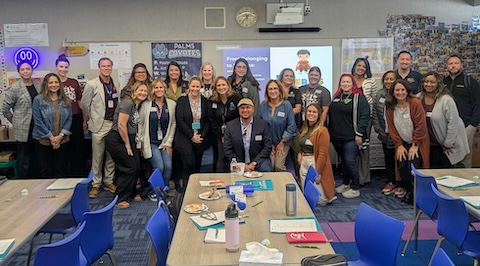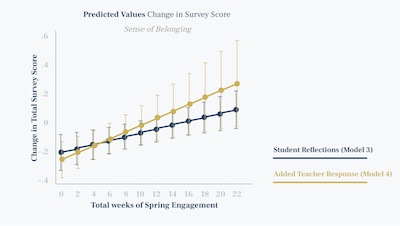Students’ Pandemic Emotions: A weekly snapshot that shows their rollercoaster


Schools across the country have moved at different paces in efforts to maintain a semblance of normalcy during the final months of the 2019–20 school year. In the past month, we’ve heard countless stories from school administrators, teachers, and parents about the stress caused by this new remote learning norm. As is expected, students are also experiencing somewhat of an emotional rollercoaster with the uncertainty.
We dug into the trends of students’ feelings over the past couple months as marked by thousands of weekly check-ins in our SEL reflection platform and found interesting, unexpected and somewhat alarming trends. The week that most schools closed across the nation saw an acute drop in emotional well-being of students. The next week there was a stark swing with improved moods, perhaps an initial celebratory spirit of being out of school. Since then, there has been a consistent decline in student self-reported emotional well-being.

These valleys and peaks were the largest swings in average emotion this entire school year, signaling that educators need to prepare for additional swings in the future. It’s also worth noting that the average emotional data is inherently skewed toward those students who have maintained engagement during school closures (about 50% in our system, in line with many national results). The trends therefore omit disengaged students, who may be struggling the most.
Overall, students wrote powerful reflections on the ‘new norm’, their experience of remote learning, and how they are coping. The following themes emerged from students’ reflections**:
Not all students have a safe space at home to continue learning
Millions of students have been required to get creative with limited space, loud siblings, and potentially stressed parents, as they seek to find quiet places to get their work done. As a high school student in South LA wrote:
“I set up my learning space in the kitchen or my room. (Privacy doesn’t exist in this house.) Concerns I have about online learning that I have is that why is this so confusing? What if I fall back with my grades? I’m concerned about my grades and this situation doesn’t seem to be helping me in any way, and there is no one to help me.”
Students who are homeless or living in poverty without internet access and dependable devices are in even more trouble to find the emotional stability to continue learning.
Students feel disconnected and are worried
A recently conducted national survey of 13–17 year olds showed that about 4 of 10 students feel more lonely than usual and an additional 40% say they feel about as lonely as usual. A sixth grader from a small town in rural Iowa reflected about their boredom and fear of not being able to maintain academic performance:
“I am a little bored being stuck in the house, but I still do some of my homework. I am also a bit worried. With Corona going on, I get out of the house once in a while, but it isn’t the same anymore.”
A high school student in Central California expressed missing capacity to see their teachers as a primary concern:
“This week was very chaotic for me and very stressful. It was kind of difficult learning everything online without seeing our teachers but I am now getting the hang of it. The most challenging for me would be to not be able to see my teachers in person”
They are struggling to deal with negative emotions
Students are dealing with new levels of stress and some are encountering traumatic experiences. A high school student in Austin wrote in a reflection on their plan for the day during their first remote learning week:
“I don’t like the high school online learning setup and therefore I haven’t done any work on it. I figure I’ll try soon but right now I don’t want that negativity in my life. I hate it so much.”
What can we do?
The data trend and reflections above paint a concerning picture, but also demonstrate students’ authenticity and emotional openness when given the opportunity to share. Some strategies we’ve seen working across the country to support students and engage them in learning include:
- Create a space for students to share their emotions, ideally as part of a consistent routine. We’ve seen a quick daily check-in work well; other ideas include regular journaling, video reflections, or live check-ins via phone or video.
- Pay attention to student responses and the tone of written work. Look for trends and shifts, and provide timely feedback to make sure students don’t get lost due to a time lag. As a best practice, we’ve seen teachers respond to students 2–3x per week when they are reflecting daily.
- Identify students who are entirely disengaged and creatively communicate with them and/or their caretakers to better understand their situation. Instead of focusing on truancy or academic work, consider checking in with them on their emotional well-being to start. Here are a few prompts to try.
- Check out one of the many free resources out there to engage students in SEL practices. We especially like the guides from the National Association of School Psychologists, CASEL, and the CDC.
Across the country educators are doing an amazing job at getting creative in identifying struggling students, and doing whatever they can to continue engaging them in a productive learning process. The task ahead remains difficult, but the effort is well worth its time to ensure whole child development continues during this pivotal new norm caused by COVID-19.
Every one of us, especially our students, will be stronger as a result.
*Aggregate emotional response data is determined based on the emoji students select when checking in each day/week, ranging from very sad (1) to neutral (3) to very happy (5). The sentiment score is a data science approach that analyzes the actual words of written student reflections and scores them on a continuum of positive to negative in tone (0=neutral). Average n=2,600+ reflections per week.
**Student reflections have been lightly edited for brevity and to ensure privacy. The tone and core content have been maintained.




.png)
.png)
.png)







